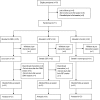A comparison of cognitive bias modification for interpretation and computerized cognitive behavior therapy: effects on anxiety, depression, attentional control, and interpretive bias
- PMID: 22963595
- PMCID: PMC3516492
- DOI: 10.1037/a0029932
A comparison of cognitive bias modification for interpretation and computerized cognitive behavior therapy: effects on anxiety, depression, attentional control, and interpretive bias
Abstract
Objective: Computerized cognitive behavioral therapy (cCBT) and cognitive bias modification for interpretation (CBM-I) both have demonstrated efficacy in alleviating social anxiety, but how they compare with each other has not been investigated. The present study tested the prediction that both interventions would reduce anxiety relative to a no-intervention comparison condition, but CBM-I would be particularly effective at modifying threat-related cognitive bias under high mental load.
Method: Sixty-three primarily Caucasian adults (mean age = 22.7, SD = 5.87; 68.3% female) with high social anxiety, randomly allocated to 3 groups: CBM-I (n = 21), cCBT (n = 21), and a no-intervention control group (n = 21) provided complete data for analysis. Pre- and postintervention (4 sessions lasting 2 weeks, control participants only attended the pre-post sessions) self-report measures of anxiety, depression, attentional control, and threat-related interpretive bias were completed. In addition, interpretive bias under high versus low cognitive load was measured using the Scrambled Sentences Test.
Results: Both CBM-I and cCBT groups reported significantly reduced levels of social anxiety, trait anxiety, and depression and improved attentional control, relative to the control group, with no clear superiority of either active intervention. Although both active conditions reduced negative bias on the Scrambled Sentences Test completed under mental load, CBM-I was significantly more effective at doing so.
Conclusions: The results suggest that although not differing in therapeutic efficacy, CBM-I and cCBT might differ in the resilience of their effects when under mental load.
Figures



Similar articles
-
Effects of standard and explicit cognitive bias modification and computer-administered cognitive-behaviour therapy on cognitive biases and social anxiety.J Behav Ther Exp Psychiatry. 2014 Jun;45(2):272-9. doi: 10.1016/j.jbtep.2013.12.002. Epub 2013 Dec 31. J Behav Ther Exp Psychiatry. 2014. PMID: 24412966 Free PMC article.
-
Modifying threat-related interpretive bias in adolescents.J Abnorm Child Psychol. 2011 Oct;39(7):967-76. doi: 10.1007/s10802-011-9523-5. J Abnorm Child Psychol. 2011. PMID: 21611733 Free PMC article. Clinical Trial.
-
Cognitive bias modification for threat interpretations: Impact on anxiety symptoms and stress reactivity.Depress Anxiety. 2020 May;37(5):438-448. doi: 10.1002/da.23018. Epub 2020 Apr 17. Depress Anxiety. 2020. PMID: 32301579 Free PMC article. Clinical Trial.
-
Cognitive bias modification for anxiety: current evidence and future directions.Expert Rev Neurother. 2011 Feb;11(2):299-311. doi: 10.1586/ern.10.194. Expert Rev Neurother. 2011. PMID: 21306216 Free PMC article. Review.
-
Internet and Computer-Based Cognitive Behavioral Therapy for Anxiety and Depression in Adolescents and Young Adults: Systematic Review and Meta-Analysis.J Med Internet Res. 2020 Sep 25;22(9):e17831. doi: 10.2196/17831. J Med Internet Res. 2020. PMID: 32673212 Free PMC article.
Cited by
-
Cognitive Bias Modification for Interpretation in Major Depression: Effects on Memory and Stress Reactivity.Clin Psychol Sci. 2015 Jan 1;3(1):126-139. doi: 10.1177/2167702614560748. Clin Psychol Sci. 2015. PMID: 25593790 Free PMC article.
-
The mediating role of resilience in the relationship between big five personality and anxiety among Chinese medical students: a cross-sectional study.PLoS One. 2015 Mar 20;10(3):e0119916. doi: 10.1371/journal.pone.0119916. eCollection 2015. PLoS One. 2015. PMID: 25794003 Free PMC article.
-
Effectiveness and Cost-Effectiveness of a Self-Guided Internet Intervention for Social Anxiety Symptoms in a General Population Sample: Randomized Controlled Trial.J Med Internet Res. 2020 Jan 10;22(1):e16804. doi: 10.2196/16804. J Med Internet Res. 2020. PMID: 31821151 Free PMC article. Clinical Trial.
-
Reactivity to Social Stress in Subclinical Social Anxiety: Emotional Experience, Cognitive Appraisals, Behavior, and Physiology.Front Psychiatry. 2016 Jan 27;7:5. doi: 10.3389/fpsyt.2016.00005. eCollection 2016. Front Psychiatry. 2016. PMID: 26858658 Free PMC article.
-
A protocol for a feasibility study of Cognitive Bias Modification training (IVY) countering fatigue in people with breast cancer.Pilot Feasibility Stud. 2024 Dec 18;10(1):151. doi: 10.1186/s40814-024-01571-8. Pilot Feasibility Stud. 2024. PMID: 39695899 Free PMC article.
References
-
- American Psychiatric Association. (1994). Diagnostic and statistical manual of mental disorders (4th ed.). Washington, DC: Author.

